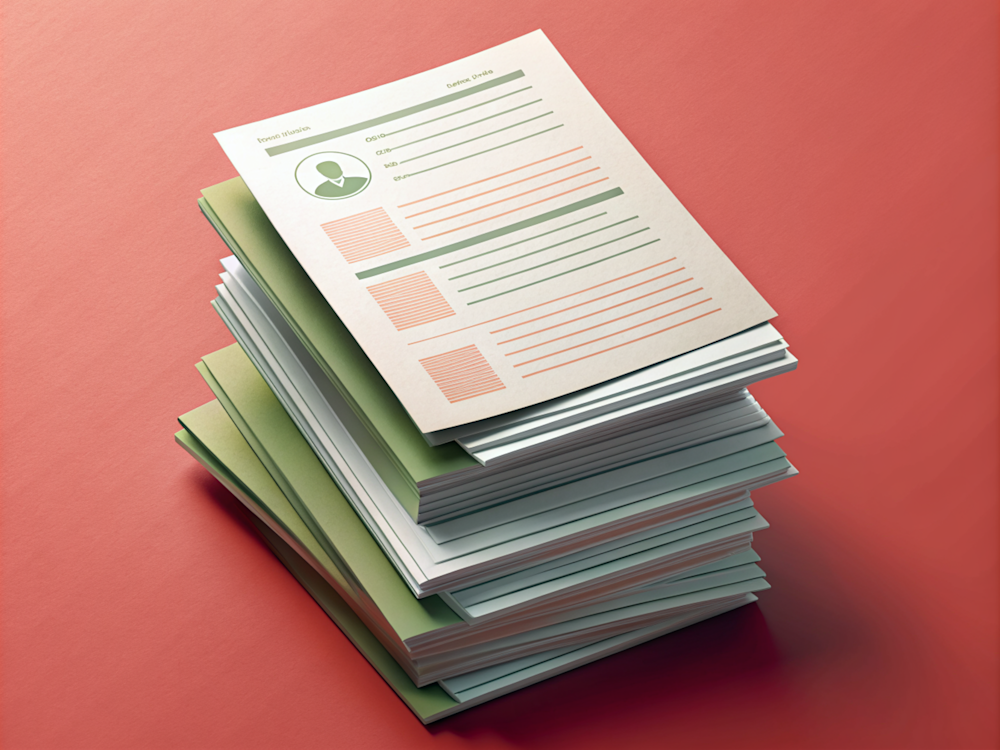Creating an Effective Resume Outline: a Step-by-Step Guide

A great resume outline is the jumping off point for a great resume!
Faced with a blank sheet of paper or, more likely, a blank Word document, deciding how best to fill it with a compelling summary of your career can seem a bit overwhelming. Fret not. With the help of our guide to creating an effective resume outline, you’ll soon be well on the way to a document you can be proud of.
Why use a resume outline?
The easiest way to banish fear of the blank page is to start getting an outline together in the form of headings and ideas. Creating a resume outline is not only an easy way to get started and get those cogs turning, it will also help you to visualize how the final document will look and to decide what information you need to prioritize. With a good structure in place, filling in each section becomes a doddle.
Let’s start creating the outline that will steer you towards a strong and engaging resume.
Five sections you need in your resume outline
We’ll start with the sections that every resume needs. Then, we’ll move onto some additional sections which you may or may not choose to include, depending on your personal circumstances.
Header
As the name suggests, the header goes at the very top of your resume. You’ll need to include these elements:
Name: You can use your preferred first name (for example Andy rather than Andrew) and your surname. No need to include middle names unless you particularly want to
Postnominals: If you have any letters after your name, for example fellowship of an industry body, add them here. Usually, first degrees aren’t included.
Title or headline: Use your current or target job title to provide an immediate reference for what you do, or create an engaging headline to grab attention.
Phone number: Just your cell phone number is fine here - there’s no need to add a landline and certainly no need to add a work number. Don’t forget to check your voicemail message to ensure it’s appropriate for recruiters and hiring managers!
Email address: Add your personal email address - ensuring it sounds professional, of course.
Location: Resumes are no longer expected to include a full mailing address, but your city, state and zip code are still required. For international job hunts, state and country is sensible, alongside a note that you’re willing to relocate.
Social links: If you have a LinkedIn profile or professional portfolio, it helps to include a link as part of your contact details. Don’t share personal social media accounts though - keep those for friends and family.
Profile
The Profile, also known as a Summary, is your elevator pitch. Rather than just regurgitating a dry summary of your career, aim for a short, dynamic paragraph that makes it clear how you can contribute to the business and succeed in the advertised role. Aim to answer:
What do you do?
What are your areas of expertise?
What is your biggest achievement in your current role?
How can you add value to the reader’s business?
Here’s an example, so that you can see the style to aim for:
“An innovative HR professional, specializing in delivering global change and transformation programs. Combines a successful record in process improvement and cost reduction with expertise in outsourcing, shared service delivery, business partnership and organizational design. Recently saved $500,000 annually by outsourcing headcount to low-cost markets. Committed to promoting diversity, inclusion, learning and development.”
Expert Tip
Resume objective statements are considered outdated now, as they focus on what you want rather than what you offer. There’s no need to include an objective in your resume outline.
Key Skills
Also known as the Core Competencies section, this is where you add your key skills in a short list. There’s no need to write long sentences or paragraphs here - the aim is to enable recruiters to see what you offer at a glance, whilst also adding some role-specific keywords that will help your resume to pop up in recruiter searches. Aim for around 8-12 skills here. For example:
Program Management | Project Management | Change Management | Business Transformation | Financial Management | Leadership | Budget Control | Risk Management | Stakeholder Engagement
Professional Experience
Now we get to the main event. This section is where you’ll detail your career history. When you’re creating your resume outline, you’ll start with your current, or most recent, job first, working backwards in time as you move down the page. For each role, add a subheading containing:
Your job title
Name of the company employing you
Your dates of employment (just months and years)
The location of the job (just the city - or “remote” if you didn’t work on site)
Below this subheading, you’ll describe the remit of the role in a couple of sentences and add a bulleted list of quantifiable achievements. Repeat the same structure for each role you’ve held in the last 10-15 years.
Education
The last compulsory section when preparing your resume outline is the Education section. A recruiter or hiring manager will expect to see:
The subject of your qualification (for example, English Language)
The level of your qualification (for example, BSc degree)
The awarding institution (for example, Stanford University)
The year you completed the degree
If you’ve been to university, there’s no need to add any earlier qualifications. Again, you’ll want to write in reverse-chronological order, starting with your most recent qualification.
Optional sections to include in your resume outline
Now you know what’s expected of every resume, let’s explore some additional sections that you could add to your resume outline to strengthen your application.
Early Career Summary
Professional Development
Volunteering
Technical Skills
Languages
Personal Projects
Hobbies and Interests
Early Career Summary
As it’s standard to only include the last 10-15 years of your career history in detail on your resume, you may need to add an Early Career Summary. This only needs to include the job title and employer name for each role, enabling you to show your career progression without wasting a lot of space on historic detail that is unlikely to be relevant to the roles you’re applying for now.
Professional Development
If you graduated from university a while back, you may have taken some courses or completed internal training since then. Employers always like to see a commitment to professional development, so list these courses and certificates on your resume.
Volunteering
An interest in social causes is always a great positive on a resume. If you’re a recent graduate, a career changer, or someone with minimal work experience, this section could take up the majority of your resume. If you’re an executive with a strong career behind you, this section might not necessitate more than one line. Decide how much space to allocate based on how relevant the skills and experience are to your current career aspirations.
Technical Skills
Anyone looking for a career in IT, as well as anyone using specialist tools in their role, would do well to consider a Technical Skills section outlining which software, hardware, apps and tools they can confidently use. Not only does this provide the opportunity to add more valuable keywords, it also shows off your competency.
Languages
If you’re lucky enough to speak a foreign language, this is definitely a skill worth adding. Even if knowledge of the language isn’t a requirement of the specific role you’re applying for, we’re working in a connected world where employers will appreciate staff who can communicate with colleagues, suppliers and customers across the globe. Remember to include your level of fluency, too.
Personal projects
Students or career changers may find that they don’t have enough professional experience to create a strong application. In that case, leaning on projects completed outside of work can provide the proof of skills and dedication that will bolster the application. There’s no need for great detail - just a brief outline that will prompt interviewers to discuss the projects further.
Hobbies and Interests
In a similar vein to personal projects, hobbies and interests can provide the opportunity to highlight skills that may not be coming through elsewhere on the resume. While “watching television” and “socializing” aren’t going to impress, if you have a pastime that will support your candidacy it’s certainly worth mentioning.
How to create a resume outline using these sections
So now we’ve covered which sections you should include, how can you use them to create a resume outline?
Add headings
For every section, create a heading. This will make your resume easy for your reader to navigate. It should stand out from the body text, so make sure it’s in a larger font - consider bold text or a different color too, although remember that you’re aiming for a professional look. Another popular choice is to break up sections with a horizontal line across the page.
Your header section does not need a heading - you can simply use your name.
Ensure consistency
Create every heading in the same style, including font, color, alignment and size. This will ensure your resume looks professional and show your attention to detail.
Consider spacing
An easy-to-read resume balances engaging content with white space. Rather than cramming in as much as you can, use an outline that focuses on presenting the information clearly. While you need plenty of white space and a font that isn’t too tiny to read, remember that you also need to keep your resume short and to the point - ideally no more than two pages.
Free resume outline example
Now you know the theory, let’s see how this could look in practice. We recommend creating your resume outline in Word, rather than Google Docs, as it’s still the most popular format. Here’s an example resume outline that just needs to be completed with the applicants’ details:
Alternative resume outlines
Above, we’ve focused on a simple resume outline that would be suitable for someone continuing in their established career path. In that case, the Header, Profile, Skills, Experience, Education, Further Details format is usually the best option.
But not everyone will be continuing in an established career. Switching the order of sections on your resume outline is fine if it serves your purposes better. For example:
Resume outline for college students and recent graduates: With minimal, if any, relevant professional experience, it’s helpful to put the focus on education by placing this section directly below Key Skills. A Hobbies and Interests section could also be valuable in this situation. In that case, the resume outline could look like this:
Resume outline for career changers: As any professional experience isn’t likely to be very relevant, career changers can benefit from an extended Key Skills section and by positioning Volunteering and Personal Projects above a shorter Professional Experience section. Again, hobbies and interests could support the application. An example of a suitable resume outline could be:
Resume outline for IT professionals: As technical knowledge is critical in these roles, IT professionals may want to position their Technical Skills section in place of the Key Skills section near the top of the resume. The resume outline would run as follows:
As you can see, while certain sections are required as best practice, you can switch around the order of these sections on your resume outline to best serve your purposes. Remember that the point of a resume is to effectively sell your skills, experience, and qualifications to a potential employer so, while your resume should always begin with a Header and Profile, you can promote your most persuasive sections to a higher position.
A strong outline results in a strong resume
Having developed a strong resume outline that emphasizes your suitability for your target role, all that remains is to fill in the details. It may take some time, but with a good outline to focus your thinking you’ll soon be ready to take the next step in your career.
Would you like an expert opinion on your resume before you send it out into the world? Why not request a free resume review from the team at ZipJob? With their advice, you’ll be able to add the finishing touches and apply for roles with confidence.

